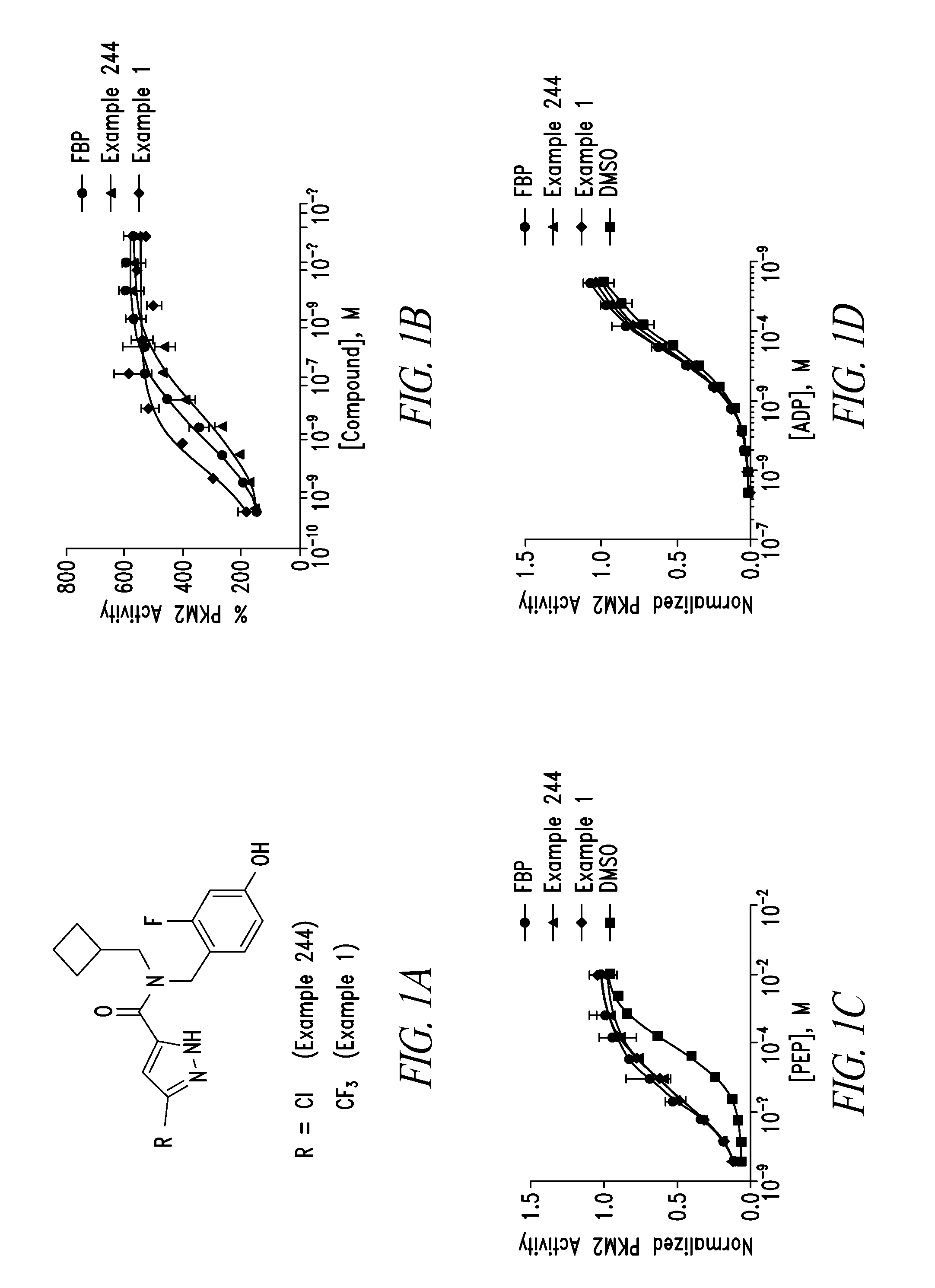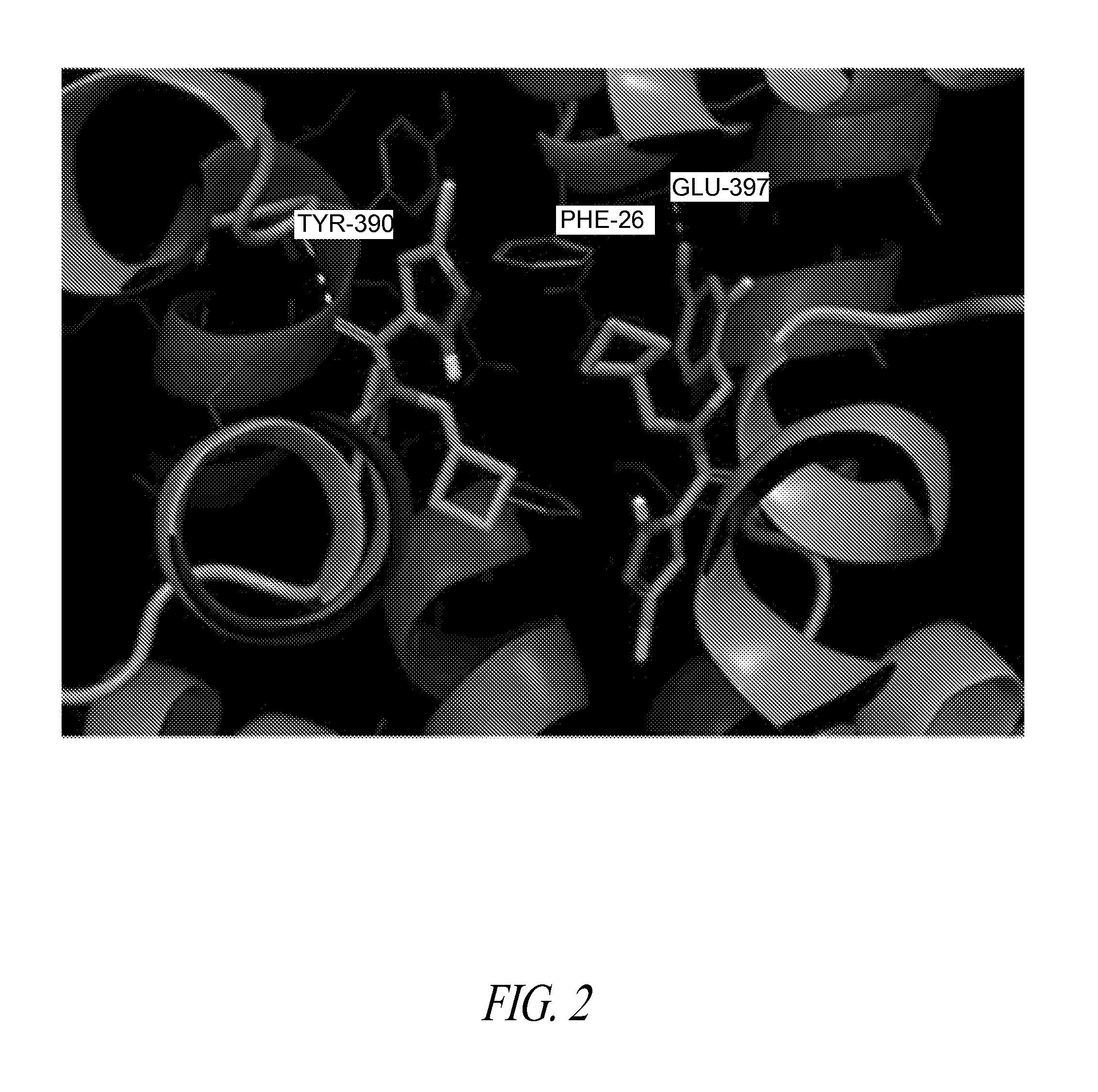Pkm2 modulators and methods for their use
a modulator and modulator technology, applied in the field of pkm2, can solve the problems of over-capacity of poorly vascularized blood vessels, the need for nutrients and oxygen,
- Summary
- Abstract
- Description
- Claims
- Application Information
AI Technical Summary
Benefits of technology
Problems solved by technology
Method used
Image
Examples
example 1
Synthesis of N-(cyclobutylmethyl)-N-(2-fluoro-4-hydroxybenzyl)-3-(trifluoromethyl)-1H-pyrazole-5-carboxamide
[0248]
[0249]To a solution of 2-fluoro-4-hydroxybenzaldehyde (0.5 g, 3.57 mmol) and cyclobutylmethanamine hydrogen chloride (0.304 g, 3.57 mmol) in methylene chloride (5 mL) was added MgSO4 (1.29 g, 10.71 mmol) and Na2CO3 (0.78 g, 7.14 mmol). The mixture was stirred at room temperature overnight, and then NaBH4 (0.16 g, 3.57 mmol) was added and stirred additional 16 h. It was quenched with methanol and diluted with 20 mL methylene chloride, and washed with water 10 mL. The aqueous layer was extracted with three 15 mL portions of methylene chloride. The combined organic extracts were washed with 10 mL of brine, dried with Na2SO4 and concentrated. The residue was purified by chromatography on silica gel eluting with 0 to 10% methanol in methylene chloride to give (0.7 g, 3.35 mmol, 94% yield) of compound 4-(((cyclobutylmethyl)amino)methyl)-3-fluorophenol.
[0250]To a solution of 3-...
example 2
Synthesis of 3-cyano-N-(cyclobutylmethyl)-N-(2-fluoro-4-hydroxybenzyl)-1H-pyrazole-5-carboxamide
[0252]To a solution of 3-cyano-1H-pyrazole-5-carboxylic acid (0.100 g, 0.729 mmol) and 4-(((cyclobutylmethyl)amino)methyl)-3-fluorophenol (0.153 g, 0.729 mmol) in DMF (1 mL) was added EDCI (0.210 g, 1.094 mmol), HOBt (0.148 g, 1.094 mmol) and DIPEA (0.283 g, 2.188 mmol). Then the reaction mixture was stirred at r.t. overnight. The resulting reaction mixture was diluted with 30 mL DCM and washed with water 20 mL. The aqueous layer was extracted with three 15 mL portions of methylene chloride. The combined organic extracts were washed with 10 mL of brine, dried with Na2SO4 and concentrated. The residue was purified by chromatography on silica gel eluting with 0 to 15% methanol in methylene chloride to give (0.026 g, 0.079 mmol, 11% yield) of compound 3-cyano-N-(cyclobutylmethyl)-N-(2-fluoro-4-hydroxybenzyl)-1H-pyrazole-5-carboxamide.
[0253]1H-NMR (CD3OD / 400 MHz): 7.05 (m, 2H), 6.54 (m, 2H), ...
example 3
Synthesis of 3-amino-N-(cyclobutylmethyl)-N-(2-fluoro-4-hydroxybenzyl)-1H-pyrazole-5-carboxamide
[0255]To a solution of 3-amino-1H-pyrazole-5-carboxylic acid (0.100 g, 0.787 mmol) and 4-(((cyclobutylmethyl)amino)methyl)-3-fluorophenol (0.165 g, 0.787 mmol) in DMF (1 mL) was added EDCI (0.226 g, 1.180 mmol), HOAt (0.159 g, 1.18 mmol) and 4-methylmorpholine (0.040 g, 0.126 mmol). Then the reaction mixture was stirred at r.t. overnight. The resulting reaction mixture was diluted with 30 mL DCM and washed with water 20 mL. The aqueous layer was extracted with three 15 mL portions of methylene chloride. The combined organic extracts were washed with 10 mL of brine, dried with Na2SO4 and concentrated. The residue was chromatography eluting with 0 to 15% methanol in methylene chloride to give (0.040 g, 0.126 mmol, 16% yield) of compound 3-amino-N-(cyclobutylmethyl)-N-(2-fluoro-4-hydroxybenzyl)-1H-pyrazole-5-carboxamide.
[0256]1H-NMR (CD3OD / 400 MHz): 7.08 (m, 1H), 6.54 (m, 2H), 5.70 (m, 1H), ...
PUM
| Property | Measurement | Unit |
|---|---|---|
| temperature | aaaaa | aaaaa |
| temperature | aaaaa | aaaaa |
| flow rate | aaaaa | aaaaa |
Abstract
Description
Claims
Application Information
 Login to View More
Login to View More - R&D
- Intellectual Property
- Life Sciences
- Materials
- Tech Scout
- Unparalleled Data Quality
- Higher Quality Content
- 60% Fewer Hallucinations
Browse by: Latest US Patents, China's latest patents, Technical Efficacy Thesaurus, Application Domain, Technology Topic, Popular Technical Reports.
© 2025 PatSnap. All rights reserved.Legal|Privacy policy|Modern Slavery Act Transparency Statement|Sitemap|About US| Contact US: help@patsnap.com



